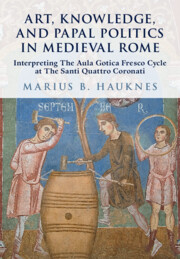 Art, Knowledge, and Papal Politics in Medieval Rome
Art, Knowledge, and Papal Politics in Medieval Rome Book contents
- Art, Knowledge, and Papal Politics in Medieval Rome
- Art, Knowledge, and Papal Politics in Medieval Rome
- Copyright page
- Dedication
- Contents
- Acknowledgments
- Introduction
- One The Santi Quattro Coronati Frescoes in Context
- Two Art, Learning, and Reflective Viewing
- Three Emblems of Time and Political Power
- Four Allegory, History, and Political Eschatology
- Five Visual and Material Entanglement in the Anagni Crypt
- Six Conclusion
- Appendix Inscriptions Appearing in the Aula Gotica Frescoes
- Bibliography
- Index
Five - Visual and Material Entanglement in the Anagni Crypt
Published online by Cambridge University Press: 30 January 2025
- Art, Knowledge, and Papal Politics in Medieval Rome
- Art, Knowledge, and Papal Politics in Medieval Rome
- Copyright page
- Dedication
- Contents
- Acknowledgments
- Introduction
- One The Santi Quattro Coronati Frescoes in Context
- Two Art, Learning, and Reflective Viewing
- Three Emblems of Time and Political Power
- Four Allegory, History, and Political Eschatology
- Five Visual and Material Entanglement in the Anagni Crypt
- Six Conclusion
- Appendix Inscriptions Appearing in the Aula Gotica Frescoes
- Bibliography
- Index
Summary
The same painters who decorated Conti’s great hall at Santi Quattro Coronati produced the sprawling network of paintings in the crypt of Anagni Cathedral just a few years earlier, during the reign of Anagni native Pope Gregory IX (1227–41). This vast expanse of frescoes represents one of the best preserved and most complex figural artworks of medieval Italy. Nearly 6,000 square feet of murals cover all available surfaces of the crypt’s interior, including its walls, apses, vaults, window ledges, pillars, columns, and capitals (Figure 5.1). The crypt’s mural program presents a strikingly diverse iconographic repertoire encompassing most categories of medieval imagery, from biblical and hagiographical narratives and iconic representations of saints to diagrams visualizing cosmological, medical, and theological concepts. A number of innovative pictorial motifs and compositional devices appear within this scheme, including in the sequence of frescoed vaults above the central aisle, which narrate the travels of the Old Testament Ark across the Holy Land in a distinctly diagrammatic compositional mode. Adding to these innovative pictorial narratives are the unusual cosmological diagrams near the crypt’s entrance. This collection of erudite motifs comprises diagrams of the microcosm, the zodiac, and planets, along with a schematic “syzygy” figure outlining the connections between the four elements and their properties (see Figure 1.10). The three cosmological diagrams are accompanied by two frescoed lunettes featuring portraits of four astrologers (no longer identifiable), and the ancient physicians Hippocrates (ca. 460–ca. 370 BCE) and Galen (ca. 129–ca. 216 CE).
- Type
- Chapter
- Information
- Art, Knowledge, and Papal Politics in Medieval RomeInterpreting the Aula Gotica Fresco Cycle at Santi Quattro Coronati, pp. 243 - 290Publisher: Cambridge University PressPrint publication year: 2025
